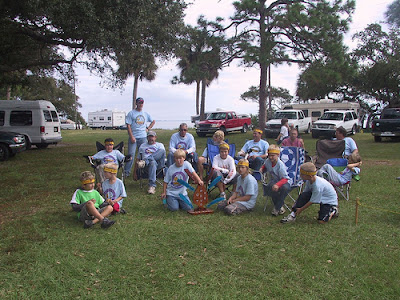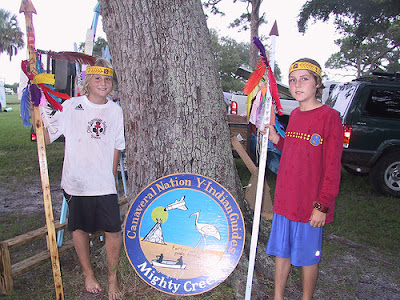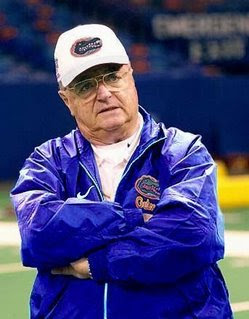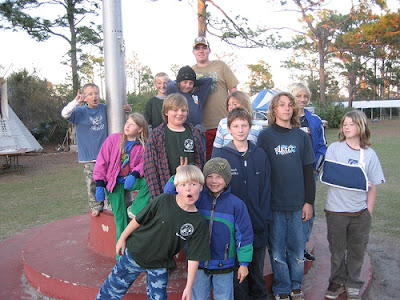Tuesday, December 18, 2007
Go Chuck, Go!
You will need speakers to enjoy this tape of young Charlie.
Monday, December 17, 2007
Sunday, December 16, 2007
The Murder of Rene LaSalle

Rene Robert Cavalier LaSalle was murdered allegedly by the members of his crew yesterday. LaSalle, the leader of the expedition to the "new world" was supposedly very difficult to get along with and his journey to the "new world" was failing. LaSalle was killed in the "new world" and the expedition will not continue to try and conquer the "new world" for France. The members of the expedition will return home in a few months. Our respects to LaSalle's family.
Thursday, December 13, 2007
Monday, December 10, 2007
Sunday, December 9, 2007
Monday, November 26, 2007
Thursday, November 22, 2007
Florida State! Florida State!

Sophomore Tim Tebow (Jacksonville, Fla.) was responsible for five touchdowns, three passing and two rushing, as the Gator football team celebrated Senior Day with a 45-12 victory over Florida State in front of 90,664 fans at Ben Hill Griffin Stadium on Saturday. UF has now defeated the Seminoles four-straight times for the first time since 1983-86.
In yet another record-breaking performance, Tebow eclipsed the school record for total offense in a season with 3,970 yards, previously held by Rex Grossman (3,904 yards in 2001). Tebow was 19-of-28 for 262 yards passing and rushed for 89 yards with two scores. He has now passed and rushed for at least one TD in 13-straight games. Sophomore wide receiver Percy Harvin (Virginia Beach, Va.) returned to the lineup after missing two games and rushed for a career-high 157 yards on 16 attempts with one touchdown.
The Seminoles opened the scoring on their initial drive of the game when senior kicker Gary Cismesia connected on a 21-yard field goal attempt for a 3-0 lead with 9:13 remaining in the first quarter.
The Gators responded in impressive fashion after Tebow shook off a Seminole defender’s attempt at a sack and ran the ball 23 yards for a touchdown. The 57-yard, seven-play drive was capped off by a successful point-after kick by senior Joey Ijjas (Clearwater, Fla.), giving the Gators a 7-3 lead with 6:28 remaining in the first quarter.
With 2:46 remaining in the period, Tebow found junior wide receiver Louis Murphy (St. Petersburg, Fla.) in the end zone for a 32-yard touchdown reception, giving the Gators a 14-3 advantage. Earlier in the drive, which spanned 68 yards in five plays, Tebow connected with senior Andre Caldwell (Tampa, Fla.) for an eight-yard completion and Harvin carried the ball for a 20-yard gain.
The aggressive Gator defense forced the Seminoles to settle for three after the offense failed to convert on third down and one to go from the Gators’ 19-yard line. The 38-yard field goal by Cismesia narrowed the Gators’ lead, 14-6, with 12:16 remaining in the half.
The following possession for the Gators began and ended with plays by Murphy. To begin the drive, Murphy made a one-handed completion for a gain of 11 yards and completed the drive with a 14-yard touchdown reception, his second of the night. Tebow spread the wealth in the 62-yard, nine-play scoring drive, connecting with receivers Cornelius Ingram (Hawthorne, Fla.), Caldwell and Harvin, each for gains of over 10 yards. With 8:48 left in the half, the Gators had a 21-6 advantage.
Cismesia connected on his third field-goal attempt of the night, this one from 28 yards, after the Gator defense held the Seminoles on third down and 10 from the Gators’ 11-yard line. The completion narrowed the Gators’ lead to 21-9 with 4:08 in the half.
The hosts matched those three points with 18 seconds remaining in the half on a 35-yard field goal conversion by Ijjas, capping off a 62-yard, 10-play drive. The Gators’ 24-9 advantage was quickly narrowed when Cismesia booted a 60-yard field goal attempt with one tick left on the clock for a 24-12 halftime score.
The Gators increased their lead to 31-12 with 12:14 remaining in the third quarter on a five-yard touchdown run by Tebow. Florida showed its ability to run the ball in the 81-yard, six-play drive, highlighted by a 20-yard carry by junior running back Kestahn Moore (Arlington, Texas), a 21-yard rush by Harvin and a 10-yard run by Tebow.
Both squads remained scoreless for the remainder of the third quarter and into the fourth until the Gators added another seven points to increase their lead, 38-12, with 8:20 left in the game. The score came off of a 31-yard reception by Caldwell and capped a 58-yard, five-play scoring drive.
After the Seminoles failed to convert on fourth and two, the Gators regained possession at the Seminoles’ 27-yard line. UF quickly took advantage with two impressive runs by Harvin; the first, a 40-yard carry and the second a 24-yard touchdown run. The touchdown extended the Gators’ lead 45-12 and proved to be the final score of the game.
Monday, November 19, 2007
Monday, November 12, 2007
Smoke Signals: (Mid-term report, Campout edition)

Aho Creeksters,
What a great meeting at the Cloud teepee this weekend. Thanks to the Kontos family for their awesome hospitality. We had some very creative craft projects completed by the Little and Big Braves.
This weekend, Nov 16-18 is the Mad Moon Campout at KARS park. We have some great activities lined up, and with a great weather weekend, there will be too much fun to be had by all.
Some items for camp consideration: Check for your name and duties required
We will be performing a skit on Saturday afternoon “displays”:
Coordinators: Kontos/Gay
Bring 2 pallets: Brophy
Bring vizqueen: Artz
Bring Dry ice: Yardley/Brophy
Bring Mulch chips: Gay
The Creek tribe is responsible for bringing the Nation trailer:
Bring to camp: Yardley
Haul away from camp: Pletcher
We need a volunteer to help Tom Brophy with pre-camp set-up on Friday.
We will be decorating the canoe as part of our craft display
Bring craft supplies: Pletcher
Friday night we will have an entry for the Golden skillet award:
Prep and serve: Yardley/Brophy
Mojito mix and serve: Artz
All members: Bring the old (coup stand) and new (leather necklace) Craft for display and coup sticks
Friday, November 9, 2007
11th Hour 11th Day 11th Month
In Flanders Fields
In Flanders fields the poppies blow
Between the crosses, row on row
That mark our place; and in the sky
The larks, still bravely singing, fly
Scarce heard amid the guns below.
We are the Dead. Short days ago
We lived, felt dawn, saw sunset glow,
Loved and were loved, and now we lie
In Flanders fields.
Take up our quarrel with the foe:
To you from failing hands we throw
The torch; be yours to hold it high.
If ye break faith with us who die
We shall not sleep, though poppies grow
In Flanders fields.
Bush stinks!
Thursday, November 8, 2007
Tuesday, October 23, 2007
History of the Indian Guide Programs

The Parent-Child Program was developed in a deliberated way to support the father’s vital family role as teacher, counselor, and friend to his son. Harold S. Keltner, St. Louis YMCA Director, as an integral part of Association work, initiated the program. In 1926 he organized the first tribe in Richmond Heights, Missouri, with the help of his good friend, Joe Friday, an Ojibway Indian, and William H. Hefelfinger, Chief of the first Y-Indian Guide tribe. Inspired by his experiences with Joe Friday, who was his guide on fishing and hunting trips into Canada, Harold Keltner initiated a program of parent-child experiences that now involves a half million children and adults annually in the YMCA.
While Keltner was on a hunting trip in Canada, one evening, Joe Friday, the Indian, said to his white colleague as they sat around a blazing campfire: “The Indian father raises his son. He teaches his son to hunt, to track, to fish, to walk softly and silently in the forest, to know the meaning and purpose of life and all he must know, while the white man allows the mother to raise his son.” These comments struck home, and Harold Keltner arranged for Joe Friday to work with him at the St. Louis YMCA.
The Ojibway Indian spoke before groups of YMCA boys and dads in St. Louis, and Mr. Keltner discovered that fathers, as well as boys, had a keen interest in the traditions and ways of American Indian. At the same time, being greatly influenced by the work of Ernest Thompson Seton, a great lover of the out-of-doors, Harold Keltner conceived the idea of a father and son program based upon the strong qualities of American Indian culture and life-dignity, patience, endurance, spirituality, felling for the earth, and concern for the family. Thus, the Parent-Child Program was born a half century ago.
Sunday, October 21, 2007
Thursday, October 4, 2007
Amo México.

INGREDIENTS
* 1 pound skinless, boneless chicken breast halves, cut into bite size pieces
* 1 cup lemonade
* 2 tablespoons olive oil
* 1 tablespoon lime juice
* 1 1/2 teaspoons Worcestershire sauce
* 1/2 teaspoon garlic powder
* 1/2 teaspoon onion powder
* 1 bay leaf
*
* 1 (12 ounce) package corn tortillas
* 1 head lettuce, shredded
* 2 large tomatoes, chopped
* 1 (8 ounce) package shredded sharp Cheddar cheese
* 1 (8 ounce) jar salsa
* 1 (8 ounce) container sour cream
DIRECTIONS
1. In a large skillet over medium heat, combine chicken, lemonade, olive oil, lime juice, and Worcestershire sauce. Season with garlic powder, onion powder, and bay leaf. Simmer until chicken is no longer pink, and juices run clear, 15 to 20 minutes.
2. Meanwhile, warm the tortillas in the oven or microwave until soft. When chicken is fully cooked, transfer to serving bowl. Place lettuce, tomatoes, cheese, salsa, and sour cream in serving dishes. Each person can create their own wrap, using their preferred ingredients.
Wednesday, October 3, 2007
Puerto Rico

The island of Puerto Rico is almost rectangular in shape, and is the smallest and the most eastern island of the Greater Antilles [Glos.]. Its coasts measures approximately 580 km, and if the adjacent islands Vieques and Culebra are included the coast measures approximately 700 km. To the north and south seas capes measure 8.525 m for the Grave of Puerto Rico and 5.000 m for the Grave of Tanner. In addition to the principal island, the Commonwealth includes: Vieques, Culebra, Culebrita, Palomino (known by some by the Spanish Virgin Islands), Mona, Monito and various others isolated islands. Deep oceans waters fringe Puerto Rico. The Mona Passage, which separates the island from Hispaniola to the west, is about 75 miles (120 km) wide and more that 3,300 feet (1,000 meters) deep. Off the northern coast is the 28,000 feet (8,500 meters) deep Puerto Rico Trench, and to the south the sea bottom descends to the 16,400 feet (5,000 meters) deep Venezuelan Basin of the Caribbean.
Monday, October 1, 2007
Latin Superstar

Roberto Clemente was a major league baseball player. He was elected to the Hall of Fame after he died. He was the only exception to the mandatory five-year waiting period since the Hall of Fame began in 1954.
Roberto Clemente was born in Puerto Rico. He played for the Pittsburgh Pirates as an outfielder. On December 31, 1972 he was taking aid to earthquake victims in Nicaragua when his plain crashed. Roberto Clemente hit 240 home runs and was said to have one of the most powerful arms in baseball. “Clemente could field the ball in New York and throw out a guy in Pennsylvania,” said a baseball announcer. He lead to Pirates to a World Series victory in 1971.
On December 23, 1972, the capital of Nicaragua was reduced to rubble by a massive earthquake. Roberto Clemente went to work sending supplies to the people. An evil dictator who was supported by the United States, “Tachito” Somoza, stole the supplies he was sending to them. Roberto Clemente decided to fly with the supplies to make sure that they would get to the people who needed them. The plane he rented to fly to Nicaragua was not very good, and the pilots did not pay attention when it was loaded. His plane crashed into the ocean and his body was never found. All that was recovered was his briefcase.
Soccer beats jogging for fitness, study suggests

Players had more fun, shed more fat, built more muscle and were less tired
LONDON - A friendly game of soccer works off more fat and builds up more muscle than jogging, new research shows.
Danish scientists, who conducted their research on 37 men, also found the soccer players felt less tired after exercising than the joggers because they were having more fun.
"This is good news for men who prefer to play football (soccer) with their mates," said Dr. Gary O'Donovan, a sports medicine expert at the University of Exeter who was not connected to the study.
To measure how hard the men were working out, the researchers strapped heart monitors to their chests and compared blood samples and muscle tissue before and after matches and jogging sessions.
The researchers selected men with similar health profiles aged 31 to 33 and split them into groups of soccer players, joggers, and couch potatoes — who not surprisingly ended the three-month study in the worst shape.
Each period of exercise lasted about one hour and took place three times a week. After 12 weeks, researchers found that the body fat percentage in the soccer players dropped by 3.7 percent, compared to about 2 percent for the joggers.
The soccer players also increased their muscle mass by almost 4.5 pounds, whereas the joggers didn't have any significant change. Those who did no exercise registered little change in body fat and muscle mass.
"Even though the football (soccer) players were untrained, there were periods in the game that were so intense that their cardiovascular was maximally taxed, just like professional football (soccer) players," said Dr. Peter Krustrup, head of Copenhagen University's department of exercise and sport sciences, who led the study.
The soccer players and the joggers had the same average heart rate, but the soccer players got a better workout because of intense bursts of activity. Krustrup and his colleagues found there were periods during soccer matches when the players' hearts were pumping at 90 percent their full capacity. But the joggers' hearts were never pushed as hard.
Unlike the soccer players, the joggers consistently thought their runs were exhausting.
"The soccer players were having more fun, so they were more focused on scoring goals and helping the team, rather than the feeling of strain and muscle pain," Krustrup said.
Friday, September 28, 2007
Tuesday, September 25, 2007
PLAN OF THE WEEK

Wednesday, October 3, 2007: Soccer Practice at 5:30 p.m. (Please note no Tuesday practice.)
Thursday, October 4, 2007: Soccer Practice at 5:30 p.m.
Saturday, October 6, 2007: LSU v. Florida (Tiger Stadium in Baton Rouge.) Kickoff is scheduled for 7:28 p.m. CST. No game for Firebirds.
Tuesday, October 9, 2007: Soccer Practice at 5:30 p.m.
Sunday, September 23, 2007
Thursday, September 20, 2007
USA send England out of World Cup
US 3, ENGIRLAND Eagles O
England were knocked out of the Women's World Cup after a 3-0 defeat by the United States in the quarter-finals.
England had held their own in the first half but a 48th-minute far-post Abby Wambach header put the USA ahead. There had been little between the sides at the start as both sides nullified each other early on.
The pace picked up after the initial sparring and it was England who started to seize the initiative as some neat passing and clever movement saw them create two chances in quick succession.
The first saw striker Eniola Aluko found in space with the chance of a clear run on goal but her hesitancy allowed the American defence to clear the threat. An angled Karen Carney cross caused concern in the US area and, although Jill Scott got a high boot to the ball, her effort was blocked and she was penalised for dangerous play. It was an encouraging start from England, who had showed tremendous resilience in holding Germany to a 0-0 draw in the group stages. And the US did not begin to assert their dominance until just before the break when they created their first significant opening.
England breathed a sigh of relief when Wambach shot over from six yards after meeting a Stephanie Lopez cross. Lilly's fierce angled strike was then produced a fine save from keeper Brown, who palmed the ball over as the half ended on even terms. But the US sustained the pressure in the second half and were rewarded with a goal when Wambach headed home to mark her 100th international appearance.
England responded by pressing for an equaliser - only to continue to come up against a resolute US defence. The creative Kelly Smith shouldered England's main hope of somehow equalising but she was marked out of the game by a US side recognising the threat she posed. A precise 20-yard shot from Boxx extended the US lead and, before manager Hope Powell's side had a chance to regroup, Brown's error let in Lilly to score and end England's challenge.
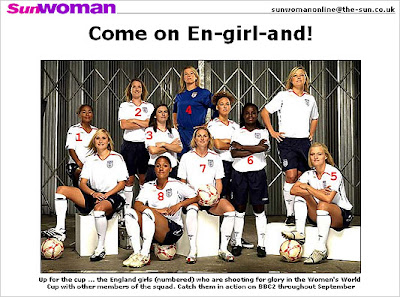
Tuesday, September 18, 2007
Saturday, September 15, 2007
Girls Rock!
United States Beats Sweden on Two Goals by Wambach
By THE ASSOCIATED PRESS
Published: September 15, 2007
CHENGDU, China, Sept. 14 (AP) — Kristine Lilly glanced up, caught sight of Abby Wambach 25 yards ahead racing down the left side toward Sweden’s goal, and lofted a soaring ball for Wambach to run under. Wambach did just that, settling the pass off her chest and lashing a left-footed half-volley from 15 yards that ripped into the net in the 58th minute.
“If you like football, you like to see a goal like Abby Wambach’s goal today,” Sweden Coach Thomas Dennerby said. “But for us, it was in the wrong match.”
It was Wambach’s second of the game — she also converted a penalty kick in the 34th minute — and it gave the United States a 2-0 victory at the FIFA Women’s World Cup. The victory moved the Americans into position to qualify for the quarterfinals. “You have to know with Kristine,” Wambach said. “Sometimes in the course of a game she can get pretty much inside herself. When she gets inside herself, I know something good is about to happen.”
Wambach played with 11 stitches in her head, picked up in a 2-2 tie against North Korea.
The victory gave the United States 4 points in Group B, the same as North Korea. The Americans’ final group game is Tuesday against Nigeria, which lost, 2-1, to North Korea yesterday.
A draw will be enough to get the United States to the quarterfinals, although a victory may guarantee first place and a quarterfinal against Japan or England. If the United States finishes second in the group, it will probably have a tougher game, against Germany, the defending champion.
In Group A yesterday, Germany and England tied, 0-0, and Japan defeated Argentina, 1-0.
Friday, September 14, 2007
Sunday, September 2, 2007
Saturday, September 1, 2007
Friday, August 31, 2007
Arron's Soccer Move
Zinedine Zidane's Classic Soccer Move
Posted Jul 02, 2006The pirouette is classic Zidane. He turns the attack forward at speed, hauls it to a stop, freezing defenders, then accelerates past. His control of the game led France to a 2006 quarterfinal victory over Brazil in the rematch of 1998's World Cup final.
After watching Zidane, get ready for a full week of soccer action. Practice Tuesday at 5:45, and then again on Wednesday. On Saturday, we will have our first game. Kickoff is at 10:30, so the players should be at the field and ready to play at 10:00!
We play Divine Mercy.
Sunday, August 26, 2007
What the heck are you doing, Coach?
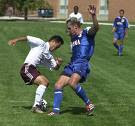
This year's coaching is based on the “Dutch Vision” method of soccer instruction. Dutch Vision is based on the revolutionary idea that soccer is a child’s game that should be fun.
Understanding soccer is a breeze when compared to understanding the children that are playing it. Each age brings unique problems. Cognitive, emotional, physical and social development will vary a great deal within the group. There is one factor that will bring all of the children together. One element that will reach everyone. They want to have fun.
Enjoyment is the unifying motive of the Dutch Vision method. Some children don't want to learn. Some don't care about winning. A few have no interest in hard work and one or two can't remember which goal they're attacking. In spite of all of their different agendas they all want to have fun and play a game, that is what brings them here.
Children also want to be children. Too often we coaches sees children as an extension of his vision and they become puppets to it. The time spent at practice and at the games is a part of their childhood. It should not reflect the adult world. Some adults forget this and their expectations take the fun out of the experience.
Growth in the learning process can be measured by the child's contribution to the game in the four main moments. The greater the contribution that the child makes the farther his learning process has developed. A child with a strong internal desire to master the game will succeed to the best of their abilities. A child that needs constant external support will not. He will only grow as far as he can be carried. Their level of motivation is one of their most important limiting factors.
In order to make a contribution it's important for them to learn how the game unfolds and to have an impact on it. Soccer is a dynamic and fluid game. Pictures and decisions change in a second. This active element creates situations that drills do not adequately address. It involves the child in reading situations, analyzing them, making predictions, arriving at decisions and finally acting on them.
OK, so you have a theory, why do you keep score, can’t kids just play? You are concentrating too much on keeping score. Why?
Fear of failure. The biggest fear of failure is the fear of losing the game. "What if I make THE mistake?" When winning and losing is restricted to game day it takes on even greater significance. There is no middle ground. Practice is meant to prepare the players for the match. When winning and losing has no place in training then arguably the most important element of the game is being neglected, the result. Children need to learn how to deal with both sides of this. That winning or losing today doesn't mean much tomorrow, that both are necessary for growth. Small sided games end with a result and with several small sided games in any practice every player will have several opportunities to experience both sides. This helps children to lower their fear of failure and leads to a more stable appreciation of what the results really mean.
Our goal: better soccer, more fun!
Saturday, August 25, 2007
Here be ye feather list.
The Green Feather

The Green Feather represents the Warrior that walks the forest and stares up at the great trees in wonder. The color of green represents life on Mother Earth. This garden of green will give him many things to sustain his life. It will give him the tools and weapons to make his life easer on earth. It will give him shelter in the harsh winters and cool shade from the hot summer sun. The trees will bare fruit to fill his belly and give his body nourishment. The Warrior will walk in the beauty and respect the thing that the Great Spirit has made. His ears will listen to The Great Spirit voice in the wind.
The Green Feather is said to be the hardest feather for a brave to earn. The Green Feather is earned by brave’s demonstrating his knowledge and stating from memory, a brief history of the Indian Guides, the Story of the Headband and the National Emblem.
A BRIEF HISTORY "The Indian father raises his son. He teaches his son to hunt, to track, to fish, to walk softly and silently in the forest, to know the meaning and purpose of life and all that he must know, while the white man allows the mother to raise his son." These chance remarks made in the early 1920s by Ojibway Indian hunting guide Joe Friday to Harold Keltner, a St. Louis YMCA director, struck a responsive chord. In 1925 Keltner arranged for Friday to speak before boys and dads in the St. Louis area. One evening after a talk given at a father and son banquet, Friday was so closely surrounded by fathers that the boys could not get near him. This gave Keltner an idea. Perhaps this strong mutual interest in the Indian could be put at the heart of a program aimed at closing the gap that he had seen widening between American fathers and their sons. Keltner designed a father-son program based on the qualities of American Indian culture and life: Dignity, Patience, Endurance, Spirituality, Feeling for the earth, and Concern for the family. From this, Y-Indian Guide programs were born.
THE STORY OF THE HEADBAND

The central theme of the headband is the Eye of the Great Spirit surrounded by the four winds of heaven. The feathered arrow designs which extend right and left of the central symbol represent the useful services of father and son. The fact that father-and-son achievements are united in the center of the design is interpreted to mean that fathers and sons together, under the eye of the Great Spirit, are seeking to help each other in the services they render.
To the right is the symbol of the mother and home. A line connects the mother symbol with the tepee, or home symbol. the fact that it is a home symbol is shown by the fire in the tepee. On the left are symbols of father and son. Their relationship again is shown by the line that joins the two symbols. These symbols add to the richness of the central theme, for it is in service to mother and home that many of the more significant achievements of father and son will take place.
Far to the right are symbols of day and forest. Far to the left are the symbols of mountain, lake, field, and stream, with the moon for night. Here again, these symbols tend to enrich the central theme, giving broader scope to services by centering the efforts of father and son on village and community life, and, as the ritual says, "in forest, field and stream."
In summary, the interpretation of the headband can be taken as "Father and son, through friendly service to each other, to our family, to this tribe, and to our community, seek a world pleasing to the eye of the Great Spirit."
ABOUT THE INDIAN GUIDES EMBLEM

The National Emblem of blue, gold, and red represents some of the main points that are stressed in Y-Guides. The cross section of an ear of corn symbolizes goodness of the Great Spirit in the life of the American Indian. The arrow head is a symbol typical of Indian life. The triangle identifies the organization as an integral part of the YMCA.
The Yellow Feather

The Yellow Feather is the color of the sacred fire that gives life to all. It represents a Warrior decision to begin his journey into life with a noble cause. It is a time for him to reflect back on his life and his accomplishments. He begins to realize that whatever success that he had achieved up until that time, the spiritual essence is missing in his life. The Yellow Feather, the color of the sun represents a new birth and beginning. The Warrior must look to the east and greet the sun and ask God for guidance. It is a time to take charge of his own destiny, to reevaluate and to set new priorities. This new journey will have a profound effect on him and everyone that comes in contact with him. Throughout this new journey the Warrior will acquire knowledge and wisdom so that he can enlighten men along the way. They will come to know that you are a man of honor and integrity. If your heart is good, they will know that they were in the presence of someone who will make a difference.
To earn a yellow feather, a little brave must be able to recite the six aims from memory. They are:
1. To be clean in body and pure in heart.
2. To be “Pals Forever” with my father/son.
3. To love the sacred circle of my family.
4. To be attentive while others speak.
5. To love my neighbor as myself.
6. To seek and preserve the beauty of the Great Spirit’s work in forest, field and stream.
The Red Feather
The White Feather
The Blue Feather
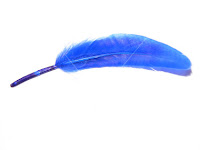
The Blue Feather represents the Warrior as he looks to the Heavens and gives thanks to The Great Spirit. He has the respect and wisdom to acknowledge the greatness of all the Heavens. He is blessed to have the clear blue sky and deep blue waters to drink from. He is honored just to walk the earth this day and looks forward to tomorrow. Each new day gives the Warrior another chance to redeem himself and if necessary reinvent himself. Forever always changing to improve oneself for the better, yet knowing he will eventually run out of time and will fall short of perfection. Little does he know, but he has set the standards for the ones that follow him. If the Warrior's heart is good, he will leave his mark and make the world a better place. He did not just occupy space while he was here. He was a leader.
The blue feather is earned for good conduct at three consecutive Tribal Meetings. The blue feather is awarded by the the Tribal Chief when he has observed the brave meeting all the other requirements. Interestingly, it is the only feather that may be taken away for not maintaining the standards of good conduct. If the feather is taken away, the brave must again demonstrate his good conduct at three consecutive meetings.
The Brown Feather
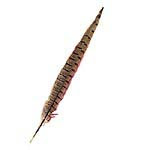
The brown feather is earned when a brave demonstrates, before the tribe, an Indian Prayer. The prayer is used in closing the Tribal Counsel. Although originally intended to be a silent prayer the words are said along with the signs to meaning to each gesture.
An Indian Prayer
And now,
(Index finger pointing to the ground)
May the Great Spirit
(all fingers circling up, imitating smoke)
Of all good spirits
(arms outstretched)
Be with
(arms coming in close)
You,
(index finger pointing across circle)
Now
(all fingers pointing down)
And forever more.
(action of shooting bow and arrow)
Of course, now would be a good time to remember that the phrase, “Great Spirit” is just another name for God the Father. Parents should take time to remind their sons of the book of Deuteronomy, Chapter 5.
Ego Dominus Deus tuus qui eduxi te de terra Aegypti de domo servitutis.
Non habebis deos alienos in conspectu meo.
Non facies tibi sculptile nec similitudinem omnium quae in caelo sunt desuper et quae in terra deorsum et quae versantur in aquis sub terra.
Non adorabis ea et non coles ego enim sum Dominus Deus tuus Deus aemulator reddens
iniquitatem patrum super filios in tertiam et quartam generationem his qui oderunt me.
I am the Lord thy God, who brought thee out of the land of Egypt, out of the house of bondage.
Thou shalt not have strange gods in my sight.
Thou shalt not make to thy self a graven thing, nor the likeness of any things, that are in heaven
above, or that are in the earth beneath, or that abide in the waters under the earth.
Thou shalt not adore them, and thou shalt not serve them. For I am the Lord thy God, a jealous
God, visiting the iniquity of the fathers upon their children unto the third and fourth generation,
to them that hate me.
The Orange Feather
The threat from aliens!

Invasive exotic species are ruining our home. Selfish homeowners are lobbing the Cocoa Beach City Commission to stop the removal of Class I alien species. Call or write your City Commissioner and tell them to protect our borders and keep the toxic illegal aliens out of Cocoa Beach.
If someone wants to see an Austrian Pine; go to Australia! Jeff sent me the link to this excellent website, proving that not everybody on Yawl Drive hates the environment. http://www.thousand-islands.org/
Thursday, August 23, 2007
Our hero - Johannes Cruijff
Hendrik Johannes Cruijff - often spelled Cruyff outside the Netherlands was born April 25, 1947 in Amsterdam is a Dutch football manager/coach and former player.
Through his career Cruijff became synonymous with the playing style of "Total Football." It is a system where a player who moves out of his position is replaced by another from his team, thus allowing the team to retain their intended organizational structure. In this fluid system no footballer is fixed in his or her intended outfield role; anyone can be successively an attacker, a midfielder and a defender. The style was honed by Ajax coach Rinus Michels around the time Cruijff came to prominence.
Strictly speaking, Cruijff played centre forward in this system. But he would drop deep to confuse his markers or suddenly move to the wing with devastating effect. No one had seen a centre forward like that before. Due to the way Cruijff played his game he is still referred to as "the total footballer."
Cruijff was known for his technical ability, speed and acceleration, but his greatest quality was vision, based on an acute sense of his team-mates' positions as an attack unfolded. The sports writer David Miller believed Cruijff superior to any previous player in his ability to extract the most from others. He dubbed him "Pythagoras in boots" for the complexity and precision of his angled passes
Tuesday, August 21, 2007
What is our goal?

Three things, technique, insight and communication; TIC. The idea is that while they are separate elements they need to be taught together, in fact in the learning process they are inseparable. Think of TIC as one word, techniqueinsightcommunication.
Training dribbling for the sake of dribbling or passing for the sake of passing misses the point. The aim of the pass or dribble is to achieve an objective, for example, to advance the ball against the opponents or keep possession. Without an objective the technique has no meaning. If the objective is not about "playing soccer" then the time is wasted.
It's normal to see technique alone being touted as the key to success in soccer. The media buzz is always about the great moments of individual brilliance that win games. These moments are truly memorable and usually center around someone's "brilliant control, deft touch, a spectacular run, acrobatic goal and so." This is reinforced with the all of the DVD's, tapes, coaching schemes, skills clinics and programs that promote technique as the key to mastering the opponent and rising to the next level. Learn these 20 moves and you'll be a star.
Technique is very important. But when it's isolated from the rest of the game there's a problem. Having the greatest technique in the world is useless if the player is not in the right place at the right time. This player can do nothing, the technique will never be utilized. However, even the worst player can do something, even if it's just get in the way or get lucky, if they are in the right place at the right time. Something always trumps nothing.
Even in the youngest players some elements of I and C will be stressed. Insight; you want to go that way, you can take the ball away from the other person. Communication; see how the ball rolls when you touch it with your foot? It's true that for these children their biggest soccer problem is the ball and that technical competence is a key. But even for young children some simple, basic ideas can be incorporated into training sessions.
By making a soccer objective the aim of the practice the children are free to experiment with their TIC. As long as they can get the job done within the rules it doesn't matter how they do it. As resistance increases they will need to improve their TIC. It is the objective of the game, and the resistance that the children have to overcome that sets the level for success. The children's motivation and abilities are their limiting factors. They are free to decide for themselves how they will solve the soccer problems. Those that want to go on to the next level will have the internal motivation to improve their own game. Those that don't can simply get off of the developmental train at that station, they have found a home.
A skillful player can execute good decisions. Poor players either cannot execute those decisions or cannot make them. That is the connection behind technique, insight and communication working together towards an aim. Reaching the objective is what is important. TIC is the means, never the end. It is the tool to get the result.








